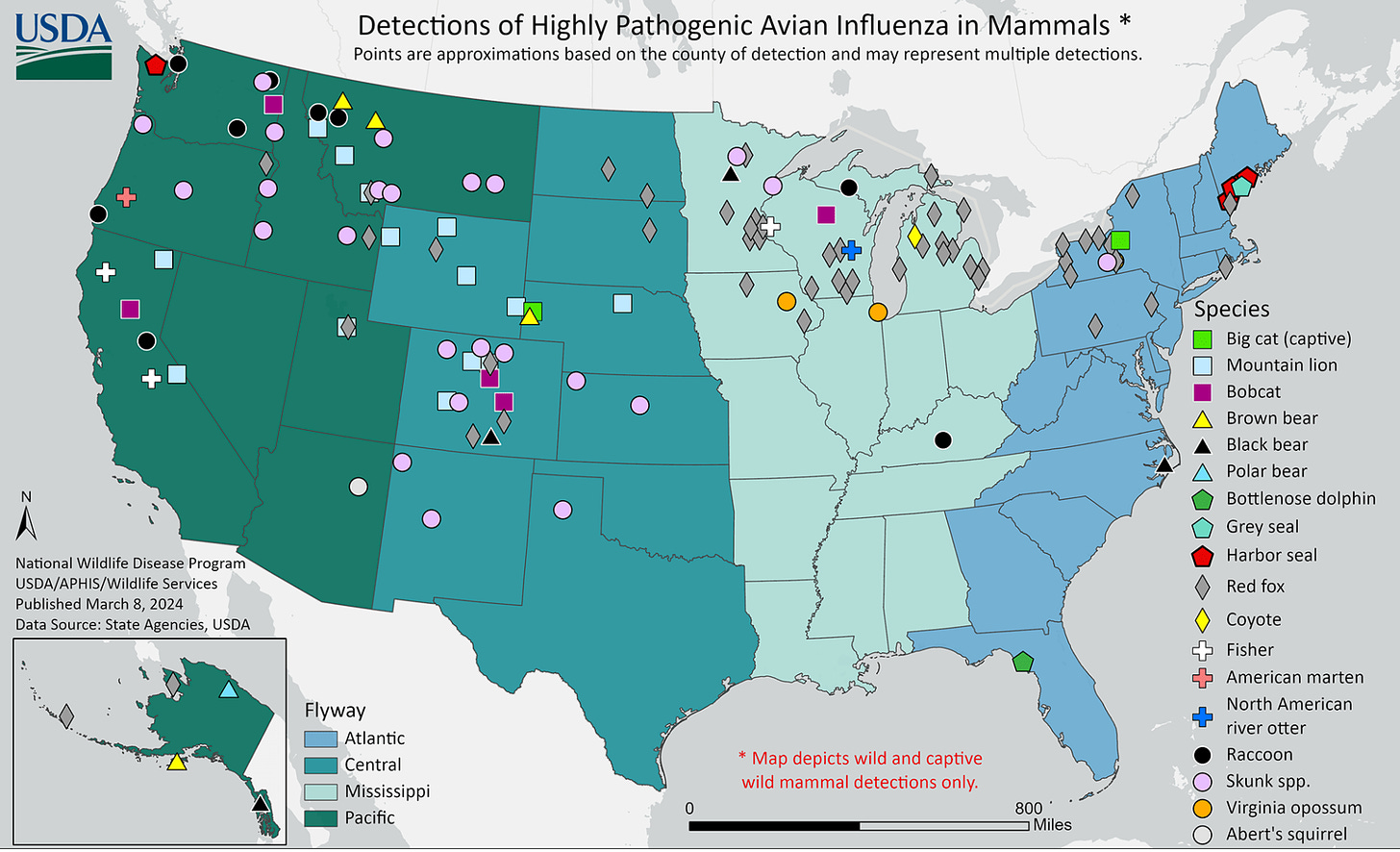Avian flu: Birds, cows, and now a human
What do we know? What do we not know?
There has been much in the news about dairy cows in Texas getting sick with avian influenza, and now a human is sick. Here is what we know, what we don’t know, and what this may (or may not) mean.
The avian flu timeline is accelerating
The version of bird flu, or avian flu, that is making the news has existed for over 20 years. We even have a name for it—highly pathogenic avian influenza virus A(H5N1), or HPAI for short. In birds, it’s highly contagious and deadly.
While it can infect humans (usually when a human has direct contact with a bird through, for example, hunting), the virus has never been able to spread efficiently among humans.
But the more this virus jumps from animal to animal or human, the more chance it has to mutate to infect humans. And things have been heating up lately:
Birds experienced an infection lull from 2016 to 2022.
Beginning in 2022, the U.S. experienced the largest and longest outbreak in U.S. history among birds, first among wild birds and then domesticated birds, like commercial chickens. These outbreaks caused eggs to be expensive and harder to find.
Then, we started detecting avian flu in mammals worldwide—seals, bears, mountain lions, and foxes, just to name a few.
This brings us to today
Last week, officials announced that HPAI infections had been detected in cows on several dairy farms across five states. We then learned that cows in other states got sick once transported from the original farm, suggesting cow-to-cow transmission. This marks the first HPAI infection in cows in the United States.

Yesterday, news was released that a person in Texas was infected with HPAI after working closely with the cows.
What we know
Lab scientists analyzed the virus that infected the cows and found:
It’s the same exact virus that is infecting birds, which suggests it jumped from bird to cow.
We are very familiar with this virus. So much so that we know where it would need to mutate to spread better from human to human. Based on preliminary analysis, the virus has not mutated in a key spot, which is great news.
The person infected had very mild symptoms—eye inflammation—and is on antiviral medication. This is good news, as the few cases of human HPAI on record have tended to be severe.
A cow isn’t a pig, which is great news. Pigs are dangerous hosts for HPAI because they have avian and human receptors. They are known as “mixing vessels” for influenza viruses. As far as we know, this is not the case for cows.
We have well-established flu vaccine pipelines and some stockpiled materials to make a matching human vaccine quickly, if necessary. We also have antivirals that can help prevent infection and severe illness.
What we do not know
Three main questions scientists are trying to answer:
Did the virus mutate to become better adapted to cows? This will require more studies, which are already underway.
Where else is it? Only a few farms are affected right now. However, viruses spread. The impact on milk supply and prices in the future is unclear.
Is the virus able to transmit onward from here? It would not be surprising if there were more human cases in people who had direct contact with cows. What we don’t know is if the virus will be able to transmit onward to other humans. For example, in the latest case, we don’t know if any of the person’s contacts became infected. Epidemiologists will closely track this.
Is there any risk to me today?
At this point, the risk to the average person is close to nil unless you’re working with wild animals, birds, or cows.
While this virus impacts the milk supply of individual cows, milk in our grocery stores is still safe to drink. Milk from sick cows is not allowed to enter the commercial supply, and milk is pasteurized—a major safety step in which milk is heated to kill pathogens, including influenza viruses.
Raw milk is unlikely to be safe, and it’s definitely not recommended anyway due to other health risks.
Bottom line
Public health eyes have been on this HPAI sucker for decades, and avian flu is finding more mammals around us. This is unsettling, but scientists continue to pay close attention. In the meantime, it may be smart to implement lessons learned from the Covid-19 emergency quickly. The time to prepare is now.
Love, YLEs (Katelyn and Caitlin)
Caitlin Rivers, Ph.D., M.P.H., is an epidemiologist at the Johns Hopkins Center for Health Security. She publishes her own newsletter, Force of Infection.
“Your Local Epidemiologist (YLE)” is written by Dr. Katelyn Jetelina, M.P.H. Ph.D.—an epidemiologist, wife, and mom of two little girls. During the day, she is a senior scientific consultant to several organizations, including CDC. At night, she writes this newsletter. Her main goal is to “translate” the ever-evolving public health world so that people will be well-equipped to make evidence-based decisions. This newsletter is free, thanks to the generous support of fellow YLE community members. To support this effort, subscribe below:







Thank you, doctors. It gives me great comfort to think of scientists working around the clock, around the globe, in all of our public health struggles. That “…trials…are already underway” is excellent to read. Scientists help me keep my clear-eyed optimism going. It ain’t easy being a clear-eyed optimist! A cloptimist, if you will ;). Your skilled information sharing is key. Many thanks.
In 2004 and 2005 I was working in Ho Chi Minh City Viet Nam (HCMC). I was also traveling to China, Thailand, Cambodia and Japan. In Viet Nam during this time there was a very bad outbreak of bird flu. Tens of millions of chickens were being destroyed (killed and then burned). This to prevent the spread of bird flu. A day did not go by without a report of a family in the countryside having a member become infected with this bird flu and dying within days (these reports were in carried in the English language daily newspaper in HCMC where I was staying and working). Often times all members of a family became infected. Children were the first to die followed by elderly family members. In many cases the whole family would die. This particular bird flu was spread by contact with infected birds. Usually these families were handling the birds as well as the birds being taken into a home.
Parenthetically 2004 was a time when the first SARS virus was waning in China. When I traveled to and from Shanghai and Beijing via plane, we were screened at every airport in China and Japan for symptoms of SARS… temperature, nose and throat were inspected, etc. Chinese and Japanese officials were taking this virus very seriously. Citizens as well with many wearing masks. More so than we are taking covid now. Since our president has proclaimed the pandemic to be over and our citizens think that covid fatigue qualifies as a pass for safety measures we're not well positioned should a new variant emerge.